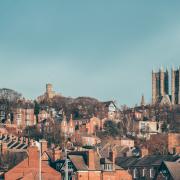It's had its ups and downs, but West Yorkshire's 'airport town' is still in high spirits, as Jo Haywood reports Photographs by Joan Russell
You don’t get many high streets higher than the one at the heart of Yeadon. Overlooked by the wonderful town hall, in all its Alpine-style grandeur, the shopping streets of this busy enclave represent one of the highest points on the compass around nearby Leeds.
Councillor Ryk Downes, who has represented Yeadon since 2004, is obviously very proud of his ward, exuberantly reeling off its many positive qualities without too much prompting. Citing the town hall, now a busy, well-used concert and event venue, the bustling Friday market with its regular band of stallholders, the good array of small, independent stores, the great bus services and the attractively refitted town hall square, he paints a very rosy picture of a town with bragging rights in abundance.
Yeadon has even managed to retain its own library and post office, which really is worth boasting about in our modern, somewhat straitened times.‘And we’ve also got Yeadon Tarn,’ said Ryk, still on a roll. ‘It’s a particularly well-used leisure area, and not just by local people. The council carried out a survey of users after investing a lot of money in new seating, a bandstand, a playground and improvements for the fish population. We discovered that people came from far and wide to visit the tarn. We even had some coming over the border from Lancashire.’
It is impossible to talk about Yeadon though and not mention the elephant in the room – or rather, the aeroplane in the room. Leeds Bradford Airport was once known to its nearest and dearest as Yeadon Airport and, while its pros and cons can be endlessly debated, it has undoubtedly proved to be a highly beneficial employer in the area.
‘About 2,700 people are employed at the airport,’ said Ryk. ‘An awful lot of people in Yeadon either work there themselves or know someone in their close circle who does. My own daughter is training there at the moment with the possibility of becoming cabin crew. The airport offers a lot of training opportunities for local people, usually with a guaranteed job interview at the end of it.’
The airport – the highest in the country – celebrated its landmark 80th birthday last year and is currently investing �11 million in improving passenger experience with enhanced shopping and leisure facilities. It is now a major player in both business and pleasure flights and is the UK’s fastest growing regional airport, but has it been a completely turbulence-free journey from 1931 to 2012?
According to Ken Cothliff, a noted aviation historian, author and display commentator who moved to the area 21 years ago, Yeadon greeted the airport when it was built 81 years ago as a welcome move forward.
‘It was actually three local businessmen, a Mr Ambler and Mr Butler, both woollen mill company directors, and Mr Hey, who owned a brewery, that approached the city fathers and suggested Yeadon,’ he explained. ‘At the time, they were thinking of Farsley (now Dawson’s corner), but that was too close to planned housing developments.
‘I know it was welcomed by the local business community. I couldn’t tell you exactly what the locals thought, but no doubt they viewed it as a step forward.’
There have inevitably been peaks and troughs in the relationship between Yeadon and its airport, with debates – heated and otherwise – occasionally arising over noise, traffic, parking (some travellers seem to think Yeadon’s residential streets are overflow parking for departures) and expansion.
But they do seem to have developed something of an entente cordial over the many years that they have spent as near neighbours. ‘If the Avro (aircraft) factory had not been built, Yeadon might have remained a bit of a backwater,’ said Ken, former owner of Yeadon shop Air Supply and organiser of Elvington Airshow. ‘But that and the rapid development of civil aviation in the 1940s and 50s brought employment to the area.
‘With the decline of the traditional industries associated with the woollen trade – there were 14 mills in Yeadon at one point – the airport has been a significant employer in the local area for the last 20 or 30 years.
‘Those who speak out against the airport are usually concerned with noise. There are very few people around now who were here before the airport though, so they’re actually voicing their angst against something that was here before they were.’
Getting there: Yeadon is about half an hour’s drive on the A65 from Leeds city centre. It is very well-served by buses with regular services to destinations around the county and has rail links to Leeds, Skipton and Ilkley via nearby Guiseley railway station. And before you ask, yes, there is an airport fairly close by (just look up and you’ll see the planes).
Parking: There are plenty of paid-for parking opportunities in Yeadon – just don’t dump your car there before jetting off to Bermuda (it annoys the locals).
What to do: The town hall is a must for music-lovers, especially those who like their tunes bursting at the seams with brass. Yeadon Tarn offers respite from the hustle and bustle of modern life with its mile-long waterside walk. And if you want to watch the big metal birds taking to the sky, the best plane-spotting sites are on Cemetery Road, opposite the end of the runway, and Layton Lane, which provides good views of the whole airport.
The print version of this article appeared in the May 2012 issue of Yorkshire Life
We can deliver a copy direct to your door – order online here


























